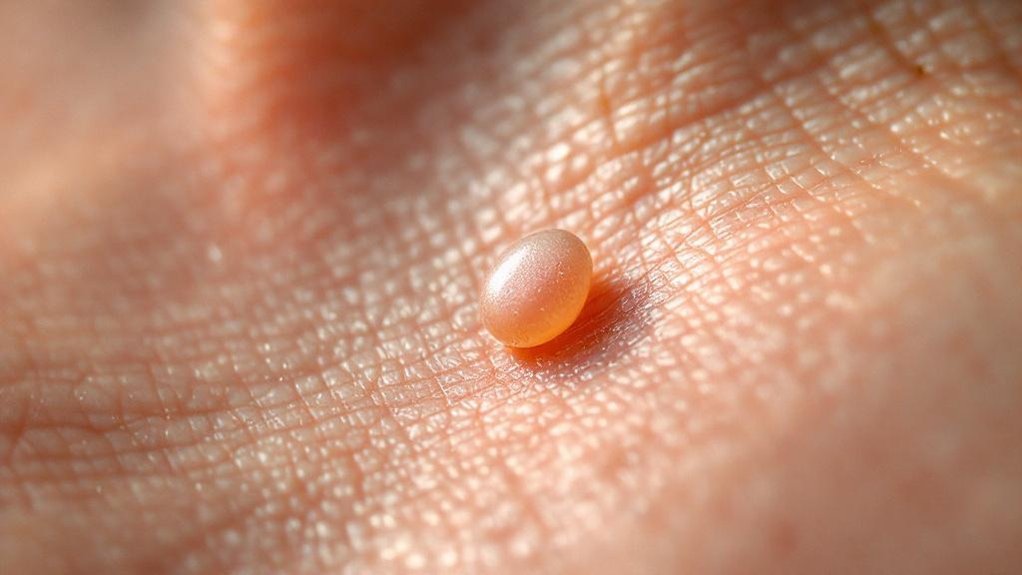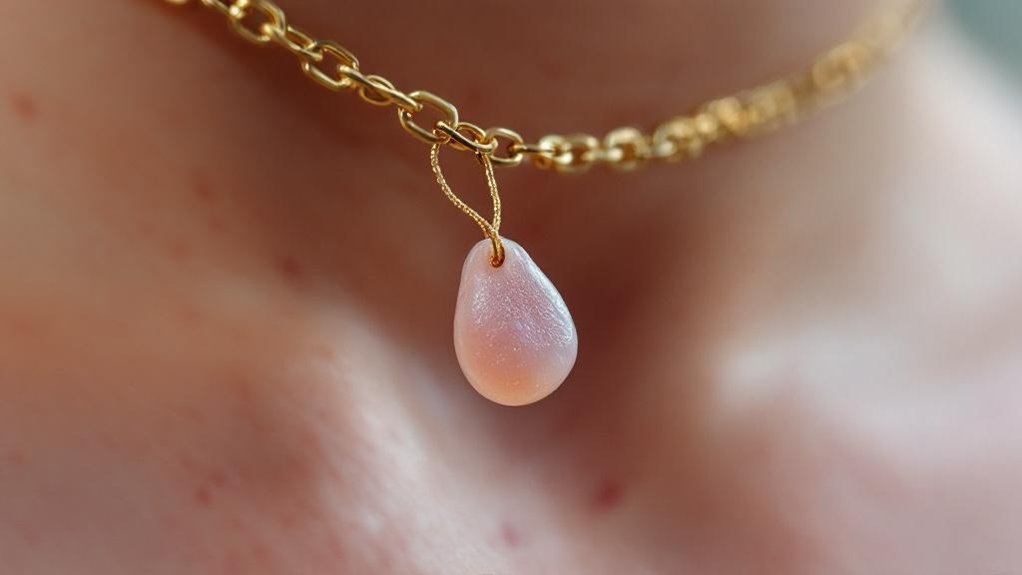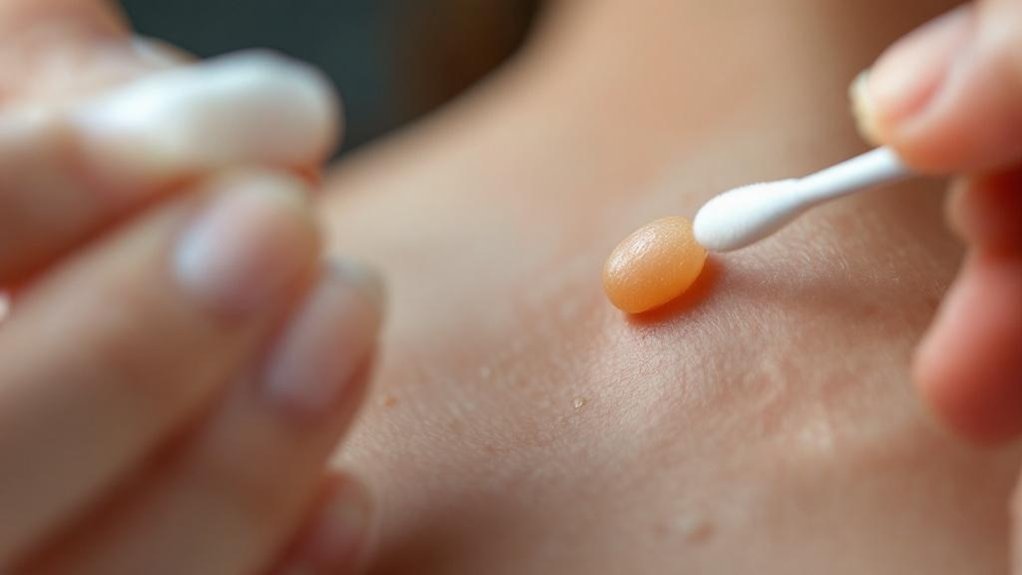Skin tags are small, benign growths that typically appear in areas where skin rubs against skin, such as the neck, armpits, and groin. These flesh-colored or slightly darker flaps of skin aren’t dangerous but can become irritated. They’re more common in people over 40, those with diabetes, obesity, or during hormonal changes like pregnancy. Several removal options exist, from medical procedures to home remedies, though professional evaluation guarantees proper treatment for your specific situation.

Skin tags, medically known as acrochordons, are small, benign growths that protrude from the skin’s surface. These soft, flesh-colored or slightly darker growths typically appear in areas where skin rubs against skin or clothing, such as the neck, armpits, eyelids, and groin.
Common skin tag causes include friction, weight gain, pregnancy, and genetic predisposition. They’re also associated with aging and certain medical conditions like diabetes. While harmless, understanding skin tag symptoms can help identify them: they’re usually small (2-5mm), painless, and hang from the skin by a thin stalk called a peduncle.
We often see patients concerned about these growths, but rest easy they’re not cancerous and don’t typically become malignant. Regular evaluations can ensure skin health, similar to how microneedling treatments can improve the appearance of various skin conditions. At our practice, we evaluate all skin growths to confirm accurate diagnosis and appropriate treatment recommendations.
While most people will develop skin tags at some point in their lives, these benign growths tend to appear in specific locations where skin frequently rubs against skin or clothing. The most common areas include the neck, armpits, eyelids, under the breasts, and groin folds.
Friction is one of the common causes of skin tags, which is why they often develop in body folds. Hormonal changes, particularly during pregnancy or with age, can also trigger their formation. Weight gain increases the likelihood as additional skin folds create more friction areas.
Different skin tag types may appear based on location and individual factors. Some remain tiny and flesh-colored, while others can become larger and darker over time. Genetics may also play a role in determining who’s more susceptible to developing them.

Beyond the common locations where skin tags appear, several specific factors increase one’s likelihood of developing these benign growths. Obesity stands as a primary risk factor, as excess skin folds create friction that can stimulate skin tag formation.
Age also plays a significant role, with most patients developing skin tags after age 40. Genetic predisposition contributes substantially to skin tag development, which explains why these growths often run in families.
Hormonal fluctuations, particularly during pregnancy or in patients with insulin resistance, can trigger their appearance. Those with type 2 diabetes face elevated risk due to insulin resistance and associated metabolic changes.
We’ve also observed increased prevalence in patients with human papillomavirus (HPV) infections and those with dysregulated cholesterol levels, suggesting complex underlying mechanisms beyond simple friction.
While many patients experiment with home remedies for skin tag removal, applications such as apple cider vinegar, essential oils, and tea tree solutions lack substantial clinical evidence supporting their efficacy.
We’ve observed that these natural treatments may cause skin irritation, chemical burns, or infection when improperly applied to the sensitive skin where tags typically form.
Our clinical recommendation remains consultation with a board-certified dermatologist for safe, effective removal rather than unproven home remedies that might complicate treatment. Moreover, medical treatments available for skin tags can ensure a higher level of safety and effectiveness in their removal process.
Apple cider vinegar isn’t recommended as a treatment for skin tags despite its popularity as a home remedy. While some online sources claim apple cider vinegar benefits include skin tag removal, there’s no scientific evidence supporting these assertions.
At the Skin and Cancer Institute, we advise against applying acidic substances like vinegar to your skin, as this can cause irritation, chemical burns, or infection—particularly in sensitive areas. Some individuals experience redness, pain, and scarring when attempting this method. Instead, we encourage you to visit our dermatology team for safe, effective skin tag removal. We offer proper medical procedures that minimize discomfort and complications.
Similar to apple cider vinegar, essential oils are frequently marketed as natural remedies for skin tag removal, but we don’t recommend them.
Despite claims about tea tree, oregano, and frankincense oils having potential benefits, there’s insufficient scientific evidence supporting their effectiveness for removing skin tags safely.
The application techniques typically involve diluting these essential oils with carrier oils and applying directly to the skin tag. However, these methods can cause skin irritation, allergic reactions, or chemical burns—particularly on sensitive areas.
At the Skin and Cancer Institute, we encourage our patients to seek professional medical evaluation for skin tags rather than experimenting with unproven home treatments. We provide clinically-validated procedures performed in a controlled environment, ensuring your safety while effectively addressing your skin concerns.
Despite the widespread promotion of tea tree oil for skin tag removal, we don’t endorse this approach at the Skin and Cancer Institute.
While proponents claim tea tree benefits include antimicrobial properties and skin-drying effects, scientific evidence supporting its efficacy for skin tag removal remains insufficient.
Some patients experiment with tea tree application methods—applying oil directly to the skin tag with a cotton ball or diluting it with carrier oils. However, these home remedies pose significant risks, including skin irritation, allergic reactions, and chemical burns if used improperly.
We recommend consulting our dermatologists before attempting any home treatment. Professional medical procedures offer safer, more effective solutions with predictable results. Our specialists can evaluate your specific case and recommend appropriate treatment options that minimize complications and optimize outcomes.
When skin tags become bothersome, painful, or cosmetically concerning, several medical removal methods can be employed by dermatologists. At our practice, we offer various techniques including laser treatment, which precisely targets and removes skin tags with minimal discomfort, and cryotherapy techniques that freeze the tissue, causing it to fall off naturally within days.
You should seek medical help if your skin tag shows changes in color, size, or shape, begins bleeding, or becomes painful. These symptoms could indicate a more serious condition requiring professional evaluation. Additionally, if you’re unsure whether a growth is actually a skin tag, it’s best to have it examined by one of our dermatologists. We’ll help determine the most appropriate removal method based on the tag’s location, size, and your personal preferences. It’s important to consult a dermatologist for a proper evaluation by a board-certified dermatologist to ensure the correct diagnosis and treatment of your skin concerns.

While complete prevention of skin tags isn’t always possible due to genetic factors, several strategies can greatly reduce your risk of developing new growths.
We recommend maintaining a healthy weight through balanced nutrition and regular exercise, as skin tags often develop where friction occurs in skin folds. Your skincare routines should include gentle cleansing of areas prone to skin tags, such as the neck, armpits, and groin.
Avoid tight-fitting clothing that causes repeated friction against the skin, and keep high-friction areas dry, especially during warm weather or physical activity.
For our patients with diabetes, proper blood sugar management is essential, as uncontrolled diabetes correlates with increased skin tag development. These lifestyle changes, while not guaranteed preventatives, can markedly minimize future occurrences.
Accurately identifying skin tags requires distinguishing them from several similar-looking skin conditions. While skin tags typically present as small, soft, flesh-colored growths that hang from the skin on a thin stalk (peduncle), other growths can appear deceptively similar.
When examining potential skin tags, we look for specific differentiating characteristics: they’re usually painless, mobile, and range from 2-5mm in size.
Unlike warts, skin tags lack the rough, cauliflower-like texture. They differ from moles by their pedunculated appearance rather than flat or raised profile.
Visual identification can also rule out seborrheic keratoses (which have a “stuck-on” appearance) and neurofibromas (which tend to be firmer). If you’re uncertain about a skin growth, we recommend professional evaluation to ascertain proper diagnosis and treatment.
After proper skin tag removal, they typically don’t grow back in the same spot. We offer effective skin tag treatment options to guarantee complete removal at our locations.
Skin tags are benign growths and rarely become cancerous. We recommend monitoring all skin tag types for changes. While we can’t prevent all skin tags, maintaining healthy weight reduces their occurrence.
Skin tags aren’t contagious or strictly hereditary. They’re commonly caused by friction, hormonal changes, and aging. We offer effective skin tag treatments including cryotherapy and excision at our practice.
Skin tags typically don’t hurt or itch. Unlike other growths requiring home remedies, they’re generally painless unless irritated by clothing or jewelry. We can help with proper skin tag differentiation during your visit.
Insurance coverage for skin tag removal typically depends on medical necessity. We’ll help determine if your insurance will cover these removal procedures, as cosmetic reasons aren’t usually covered by most plans.
We’ve found that skin tags, while benign, can impact our patients’ quality of life. Through evidence-based approaches ranging from cryotherapy to excision, we’re able to address these growths with minimal discomfort. Remember, proper diagnosis is essential, as some lesions may mimic skin tags but require different treatment. We encourage consulting with a board-certified dermatologist to determine the most appropriate intervention for your specific needs.